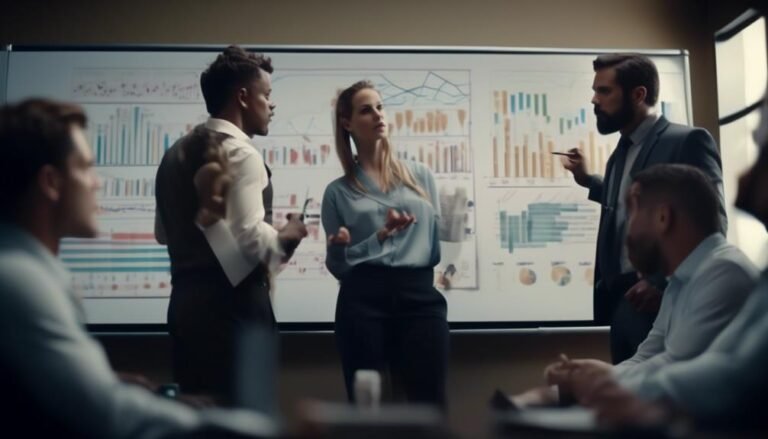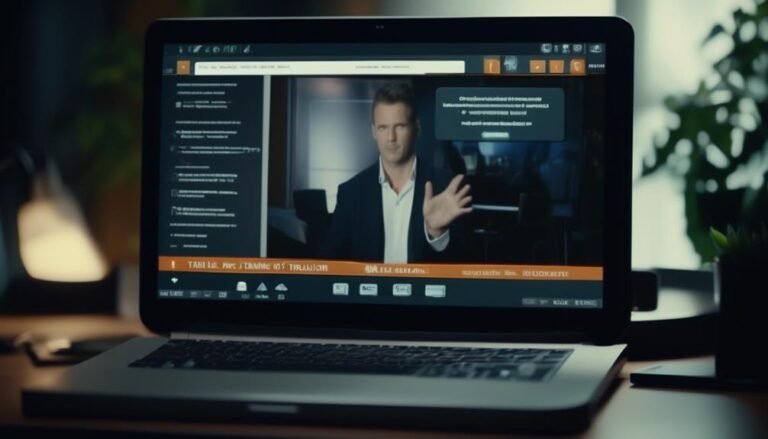Why Multi-Device Learning Is Essential for Today’S Workforce
In today's rapidly evolving professional landscape, the necessity for continuous learning has become a non-negotiable requirement. The demand for upskilling and reskilling is at an all-time high, and the traditional approach to learning no longer suffices.
As professionals strive to stay competitive and relevant, the concept of multi-device learning has emerged as a critical component. This approach offers a range of benefits that cater to the diverse needs and preferences of modern workers.
From the changing work dynamics to the imperative of future-proofing skills, the relevance of multi-device learning in today's workforce cannot be overstated.
Key Takeaways
- Remote collaboration and virtual teamwork are increasingly prevalent in the modern workplace, requiring employees to have access to educational resources across various devices.
- Multi-device learning solutions cater to different learning styles and preferences, providing employees with accessibility and flexibility in their learning experience.
- Interactive and multimedia elements, personalized learning paths, and real-time feedback enhance the learning environment, improving retention rates and knowledge sharing within the workforce.
- Adaptability and agility in learning are crucial for professionals to respond quickly to evolving industry trends and stay ahead in a fast-paced work environment. Multi-device learning facilitates seamless transitions between different platforms and supports adaptive learning strategies.
Changing Work Dynamics
The modern workplace is undergoing a significant transformation, driven by technological advancements and shifting employee expectations. One of the most notable changes is the increasing prevalence of remote collaboration and virtual teamwork. With the rise of digital communication tools and platforms, teams are no longer confined to working in the same physical space. Instead, they can collaborate and work together from different locations, whether it's across the city or around the globe.
Remote collaboration and virtual teamwork have become essential components of the modern work environment. They enable organizations to tap into a global talent pool, foster diversity, and offer employees greater flexibility in managing their work-life balance. Furthermore, these approaches can lead to increased productivity and efficiency as teams leverage technology to communicate, share ideas, and coordinate activities in real time.
However, while remote collaboration and virtual teamwork offer numerous benefits, they also present challenges. Communication barriers, time zone differences, and the lack of face-to-face interaction can hinder effective collaboration. Therefore, organizations must invest in the right technology and provide adequate training to ensure that remote teams can work cohesively and achieve their objectives despite physical distance.
Accessibility and Flexibility
Amid the changing work dynamics driven by technological advancements and shifting employee expectations, the current focus shifts to the critical aspects of accessibility and flexibility in the modern workplace.
Remote learning has become increasingly prevalent, and as a result, the need for accessibility across various devices has become paramount. Employees, whether in the office or working remotely, require seamless access to educational resources and materials. This necessitates the integration of multi-device learning solutions that cater to different learning styles and preferences, thereby promoting personalized education.
Accessibility and flexibility are no longer just desirable attributes but have become essential components of an effective learning environment. Employees need the flexibility to engage in learning activities at their own pace, anytime and anywhere, to accommodate their work schedules and individual commitments.
Furthermore, the provision of accessible learning materials across multiple devices ensures that employees with diverse needs and preferences are equally supported. This inclusivity fosters a more engaged and productive workforce.
As such, organizations must prioritize the implementation of multi-device learning strategies to ensure that accessibility and flexibility are embedded into the fabric of their learning culture.
Enhanced Learning Experience
In the modern workplace, an enhanced learning experience is essential for fostering employee development and achieving organizational goals. To ensure that employees are equipped with the knowledge and skills needed to excel in their roles, it is crucial to provide learning opportunities that go beyond the traditional classroom setting.
Here are three key elements that contribute to an enhanced learning experience:
- Improved Retention: By incorporating interactive and multimedia elements into learning materials, employees are more likely to retain information. Interactive engagement through simulations, gamified learning, and virtual reality experiences can significantly improve retention rates, ensuring that the knowledge gained is effectively retained and applied in real-world scenarios.
- Personalized Learning Paths: Tailoring learning experiences to individual employee needs and preferences can greatly enhance the overall learning experience. Utilizing multi-device learning allows employees to access personalized learning paths that cater to their specific learning styles, pace, and interests, leading to a more effective and engaging learning journey.
- Real-time Feedback and Collaboration: Multi-device learning enables real-time feedback and collaboration among employees, fostering a dynamic and interactive learning environment. Through tools such as instant messaging, discussion forums, and collaborative project platforms, employees can engage with instructors and peers, receive immediate feedback, and actively participate in the learning process. This real-time interaction enhances the overall learning experience and promotes knowledge sharing and collaboration within the workforce.
Adaptability and Agility
The adaptability and agility of today's workforce are crucial for success in a rapidly evolving business landscape.
Flexibility in learning allows employees to quickly acquire new skills and knowledge to keep up with changing demands.
Moreover, the advantages of device diversity enable seamless transitions between different platforms, ensuring a smooth and efficient learning experience.
Flexibility in Learning
Exercising adaptability and agility in learning is essential for modern professionals to navigate the ever-evolving demands of the workforce. In the context of remote education, adaptive learning strategies are crucial for individuals to effectively absorb new information and skills.
Flexibility in learning can be achieved through:
- Embracing a growth mindset: Being open to new ideas and approaches allows professionals to adapt to changing circumstances and learn new skills.
- Utilizing multi-device learning: Accessing educational resources across various devices enables individuals to learn at their own pace and in their preferred environment.
- Seeking continuous feedback: Regularly soliciting input from peers, mentors, or online platforms facilitates ongoing improvement and the ability to quickly adjust learning strategies.
Quick Response to Change
Navigating the dynamic demands of the modern workforce requires professionals to swiftly adapt and demonstrate agility in response to change. Adaptive learning plays a crucial role in enabling professionals to respond quickly to evolving industry trends and job requirements.
Rapid skill acquisition is essential for professionals to stay ahead in a fast-paced work environment. With adaptive learning, individuals can efficiently acquire new skills and knowledge, allowing them to pivot and adjust to changing circumstances.
This adaptability and agility are increasingly important as industries undergo rapid transformation due to technological advancements and global shifts. Professionals who can quickly respond to these changes are better positioned to thrive in today's competitive workforce.
Therefore, embracing adaptive learning and fostering rapid skill acquisition is imperative for professionals seeking to remain relevant and effective in their respective fields.
Device Diversity Advantages
In the context of the rapidly evolving workforce, professionals' ability to efficiently adapt and demonstrate agility in response to change is complemented by the advantages of device diversity, which play a pivotal role in fostering adaptability and agility in the modern work environment.
- Device Compatibility: With a variety of devices available, professionals can seamlessly transition between devices, ensuring that their work is not hindered by compatibility issues.
- Learning Optimization: Device diversity allows for optimized learning experiences, as individuals can choose the device that best suits their learning style and preferences.
- Flexibility and Accessibility: Professionals can access information and resources from anywhere, at any time, using different devices, thereby enhancing their flexibility and accessibility in the workplace.
The adaptability and agility facilitated by device diversity are crucial in meeting the dynamic demands of the modern workforce.
Productivity and Efficiency
Enhancing productivity and efficiency in the modern workforce is essential for achieving optimal performance and meeting organizational goals. Multi-device learning plays a crucial role in improving engagement and enabling remote collaboration, ultimately leading to enhanced productivity and efficiency. Here's a comparison of how multi-device learning contributes to productivity and efficiency:
| Aspects | Impact of Multi-Device Learning |
|---|---|
| Flexibility | Enables employees to access learning materials and tools from various devices, allowing them to learn at their convenience, leading to improved time management and productivity. |
| Collaboration | Facilitates seamless remote collaboration among team members, allowing for real-time interaction and knowledge sharing, leading to more efficient and effective teamwork. |
| Accessibility | Provides easy access to learning resources across different devices, ensuring that employees can engage in learning activities regardless of their location or the devices they have access to, thus boosting overall productivity. |
Professional Development Benefits
Developing professional skills through multi-device learning offers employees the opportunity to enhance their expertise and adapt to the evolving demands of the workforce. This modern approach to learning provides several benefits for professional development, including:
- Skill Acquisition: Multi-device learning allows employees to acquire new skills and knowledge conveniently, enabling them to stay relevant and competitive in their respective fields.
- Career Growth: By engaging in multi-device learning, individuals can broaden their skill sets, making them more valuable assets to their organizations and opening up opportunities for career advancement.
- Personal Development, Professional Advancement: Multi-device learning facilitates continuous personal and professional growth, empowering employees to take charge of their career development and progress towards their professional goals.
Embracing multi-device learning not only enriches employees' capabilities but also contributes to the overall success and resilience of modern businesses. As the workforce continues to evolve, organizations that prioritize multi-device learning for professional development will undoubtedly gain a competitive edge in the dynamic and demanding global marketplace.
Future-Proofing Skills
Future-proofing skills is essential in today's rapidly evolving workplace.
Skill adaptability, tech integration, and continuous learning are key points to consider when it comes to staying ahead in a competitive job market.
As technology continues to advance, individuals need to be proactive in developing and honing their skills to remain relevant and valuable in the workforce.
Skill Adaptability
In today's rapidly evolving work environment, the adaptability of one's skills has become increasingly crucial for maintaining professional relevance and effectiveness.
Adaptive learning allows individuals to tailor their learning experiences to suit their specific needs, ensuring that skills remain relevant and up-to-date.
Skill versatility is essential for employees to seamlessly transition between different tasks and roles, especially in dynamic work settings.
Embracing a growth mindset fosters the ability to continuously learn and adapt, enabling professionals to stay ahead in their careers.
Leveraging technology for continuous upskilling and reskilling ensures that individuals remain competitive and adaptable in the face of changing job requirements.
These factors collectively contribute to future-proofing skills, enabling individuals to thrive in an ever-changing professional landscape.
Tech Integration
Amidst the rapidly changing work environment, integrating technology into skill development has become imperative for professionals to ensure their expertise remains future-proof. However, this integration poses several challenges, including the need for up-to-date knowledge of technological advancements and the ability to adapt to rapidly changing tools and platforms. Professionals are required to navigate through a myriad of technological advancements, such as artificial intelligence, machine learning, and automation, to integrate them seamlessly into their skill development. The table below outlines some of the integration challenges and technological advancements professionals need to consider:
| Integration Challenges | Technological Advancements |
|---|---|
| Up-to-date knowledge | Artificial Intelligence |
| Adapting to new tools | Machine Learning |
| Platform flexibility | Automation |
Navigating these challenges and embracing these advancements is crucial for professionals to future-proof their skills in today's fast-paced work environment.
Continuous Learning
The pursuit of continuous learning is a fundamental strategy for professionals seeking to fortify their skill sets and remain adaptable in an ever-evolving work landscape. As the demands of the modern workforce continue to shift, individuals must prioritize continuous education to future-proof their careers.
Key elements to consider include:
- Flexible Training: Embracing a flexible approach to training allows professionals to acquire new skills while managing their existing work commitments, ensuring minimal disruption to their productivity.
- Continuous Education: Engaging in ongoing education initiatives, such as online courses, webinars, and workshops, enables professionals to stay abreast of industry developments and emerging trends.
- Adaptability: Cultivating an adaptable mindset through continuous learning empowers individuals to navigate dynamic work environments and swiftly respond to changing job requirements.
Conclusion
In conclusion, multi-device learning is crucial for today's workforce due to its ability to adapt to changing work dynamics, enhance accessibility and flexibility, and improve productivity and efficiency.
It provides an enhanced learning experience and promotes adaptability and agility, contributing to professional development and future-proofing of skills.
Embracing multi-device learning allows individuals to stay relevant and competitive in the ever-evolving workplace landscape, ensuring they are well-equipped to face future challenges.







